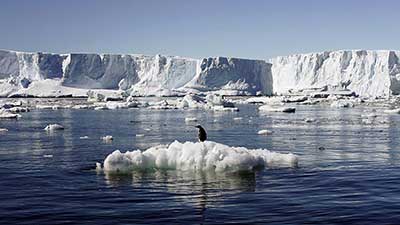Date : 27/09/2023
Relevance – GS Paper 3 – Environment and Ecology
Keywords – Climate System, Sea ice thickness, Stratospheric Ozone
Context
Antarctica's sea ice, a crucial component of the Earth's climate system, has been on a worrisome decline, marking record-breaking lows in recent years. This trend is particularly concerning as it defies earlier expectations and has significant implications for global climate dynamics.
Antarctica's Sea Ice Dynamics
Antarctica's sea ice, a layer of frozen seawater surrounding the continent, undergoes seasonal fluctuations, with maximum coverage typically in September and a minimum in February. Over the past two seasons, it has exhibited a consistent decline, tracking well below the winter maximum levels recorded since satellite monitoring began in the late 1970s. Moreover, the summer minimum has also decreased, with three record low summers occurring in the last seven years.
This decline is alarming as sea ice plays a critical role in regulating the Earth's climate. It reflects solar energy back into the atmosphere, thus helping to cool the planet. Additionally, sea ice formation contributes to the creation of cold, salty water masses that drive global ocean currents. Consequently, any significant changes in Antarctica's sea ice have far-reaching consequences for the Earth's climate system.
India's Engagement in Antarctica:
- Antarctic Treaty Adherence: India formally joined the Antarctic Treaty System on August 1, 1983, and subsequently became the fifteenth Consultative Member of the Antarctic Treaty on September 12, 1983.
- Research Stations: India established research stations like Dakshin Gangotri (now decommissioned) and Maitri, Bharti to facilitate scientific research activities in Antarctica.
- Formation of NCAOR: The National Centre for Antarctic and Ocean Research (NCAOR) was established to coordinate and conduct India's research endeavors in the Polar and Southern Ocean regions.
- Indian Antarctic Act 2022: This legislation aims to regulate visits and operations in Antarctica, addressing potential disputes among those present on the continent. It includes provisions for safeguarding mineral resources, protecting indigenous plant life, prohibiting the introduction of non-native bird species to Antarctica, and regulating Indian tour operators.
Unpredictable Trends

The recent decline in Antarctic sea ice has left scientists puzzled, as it contradicts earlier expectations. While the Arctic has witnessed a long-standing trend of diminishing sea ice, Antarctica has shown a small increasing trend in sea ice extent from 2007 to 2016, followed by a decrease in recent years. This erratic behavior presents a significant challenge for climate models.
Climate models, our primary tools for forecasting future climate, have struggled to accurately simulate Antarctic sea ice. These models, developed over decades, incorporate various components representing the atmosphere, oceans, energy transfer, land surface properties, and sea ice evolution. While they have excelled in forecasting aspects like ocean and land surface warming, simulating Antarctic sea ice has proven elusive.
Modeling Challenges
Several factors contribute to the modeling challenges surrounding Antarctic sea ice. Changes in wind and wave patterns, natural variability, stratospheric ozone fluctuations, and meltwater from the Antarctic ice sheet entering the Southern Ocean have all been proposed as potential explanations for the observed sea ice decline. However, none of these factors has emerged as the definitive answer.
One of the significant limitations in understanding Antarctic sea ice is the lack of direct measurements of sea ice thickness. Unlike the Arctic, where data from submarines and other sources provide insights into sea ice thickness, information about Antarctic sea ice thickness remains scarce. Existing data mostly come from land-fast sea ice, which is attached to land or ice shelves. This leaves large gaps in our understanding of sea ice volume, a crucial metric for assessing the impact of climate change on sea ice.
Anomalies in Sea Ice Thickness
Recent anomalies in sea ice thickness have added to the complexity. In 2022, storms in McMurdo Sound dramatically thinned the sea ice, which typically reaches about two meters in thickness. Snow cover, thicker than usual in some areas, further impeded ice growth by insulating it from the cold air. Although the thinner sea ice didn't result from melting but rather from being blown out by strong winds, it disrupted Antarctic operations significantly.
However, in 2023, sea ice in McMurdo Sound formed similarly to most years, despite extremely low winter sea ice extent around most of Antarctica. The extent of climate change's role in driving these anomalies remains uncertain, but they may foreshadow future trends.
The Way Forward
Predicting changes in Antarctic sea ice requires improved modeling capabilities, increased measurements of critical factors driving sea ice changes, and innovative measurement methods. The complexities of Antarctica's sea ice decline underscore the intricate interplay of climate factors and the challenges in foreseeing their consequences.
Antarctica's sea ice decline is a multifaceted puzzle with implications for Earth's climate system. While it defies earlier expectations and presents modeling challenges, understanding this phenomenon is crucial for addressing climate change and its impact on polar regions.
Probable Questions for Mains Examination –
- Discuss the recent decline in Antarctic sea ice, its impact on global climate dynamics, and the challenges it poses to climate models. How can improved modeling capabilities and enhanced measurements contribute to a better understanding of this phenomenon? (10 marks, 150 words)
- Examine the factors contributing to the decline in Antarctic sea ice and the unpredictability of its trends, contrasting it with the well-documented decline in Arctic sea ice. What are the potential implications of Antarctic sea ice changes for the Earth's climate system, and how can policymakers address these challenges in the context of climate change mitigation and adaptation? (15 marks, 250 words)
Source –DTE







